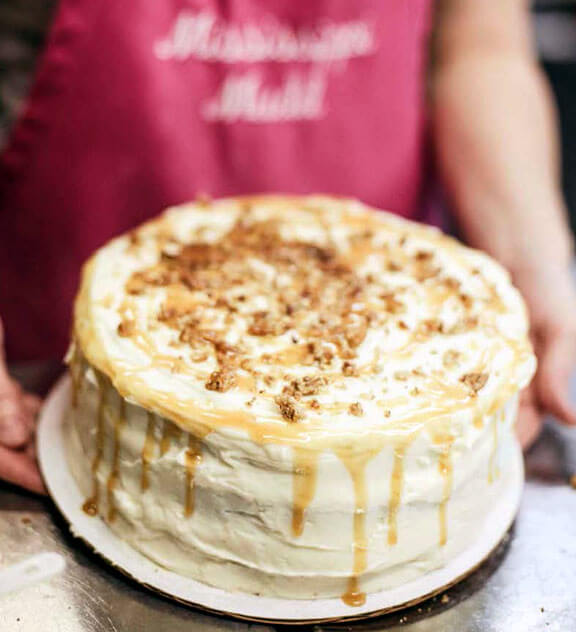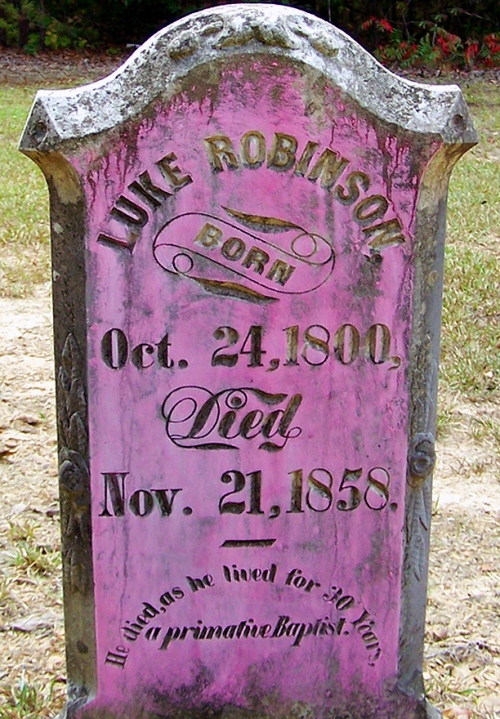The following excerpt comes from Elmo Howell’s wonderful Mississippi Back Roads (Langford: 1998). This old church deserved a far better fate.
In the beginning, all Baptists were Primitive Baptists. Following the Reformation, the Anabaptists, along with Calvinists, Waldensians, Mennonites and other radical groups, departed from Church and State to live a holy life according to the Gospels. Today most Baptists in the South belong to the giant Southern Baptist Convention, but the small scattered congregations in the hill country who still have no Sunday School, no foreign missions, no paid clergy, and who still wash each other’s feet in solemn ceremony—in keeping with Christ’s example and an ancient Maundy Thursday rite—are the true descendants of the original Baptists. They are the Primitives, the Hardshells.
Baptist worship began in Mississippi in the 1780’s when Elder Richard Curtis came out from South Carolina and settled with a small flock on Cole’s Creek above Natchez. Spain ruled the country, Roman Catholicism was the state church, but for awhile all went well with Protestants in private worship. Then word got out that Curtis was performing marriage ceremonies, taking in converts, and even talking about building a church. In a government crackdown, five or more persons found together in a religious capacity were subject to arrest. He ignored the warning—but escaped, it is said, through the offices of a half-Indian convert, Aunt Chloe Holt, who roused him in the night with a horse and saddle and provisions for his journey. At the end of Spanish rule, Curtis returned to Mississippi and spent the rest of his life with the Baptists in Adams County.
 In the half century following this rude beginning in Mississippi, a great revolution swept over Baptists everywhere, the “Fuller Heresy,” as the Primitives called it, or the advent of the “missionaries” with their charge to evangelize the world. Baptists began with a stern predestinarianism, which among “Southern Baptists,” organized in the 1840’s, gave way to prevalence of grace and open communion. The old remnant held on to “total depravity” and man’s incapacity to restore himself to favor with God. They rejoiced in Election, God’s choosing “whom He would,” and left it to the mystery of love that some are saved, some lost. “Ye have not chosen me, but I have chosen you and ordained you.” This heady doctrine provoked an extraordinary reaction in both life and literature in England in the 17th
In the half century following this rude beginning in Mississippi, a great revolution swept over Baptists everywhere, the “Fuller Heresy,” as the Primitives called it, or the advent of the “missionaries” with their charge to evangelize the world. Baptists began with a stern predestinarianism, which among “Southern Baptists,” organized in the 1840’s, gave way to prevalence of grace and open communion. The old remnant held on to “total depravity” and man’s incapacity to restore himself to favor with God. They rejoiced in Election, God’s choosing “whom He would,” and left it to the mystery of love that some are saved, some lost. “Ye have not chosen me, but I have chosen you and ordained you.” This heady doctrine provoked an extraordinary reaction in both life and literature in England in the 17th 
Loosascoona Primitive Baptist Church at old Airmount east of Coffeeville is a remarkable survivor, in both church organization (still with regular services) and in an old building perhaps a century and a half old. No one knows when it was built. In 1839, the Yalobusha Baptist Association in central Mississippi split in two in the controversy between old and new. Five churches broke away to form the Loosascoona Primitive Baptist Association. “I am not of you,” one elder spoke out at the meeting, “and that it may be manifest that I am not of you, I now go out of you.” And so it was in Yalobusha County, as throughout the state, that the old Baptists withdrew to their hills and hollows, a small but sturdy remnant to carry on in their own way.
The church organization at Airmount lasted for a century, but with membership down to only four families in 1938, services were discontinued. The doors were closed, the house was given a new tin roof, left to itself and forgotten. Undergrowth moved into the clearing. Then in 1965, one surviving member had a dream—he dreamt of going to church again in the woods with his father. Under the leadership of William Tyler “Dub” Wortham and Guy Shaw of Coffeeville, Loosasaoona was brought back to life. The Murphree 
The Primitives, overlooked in the bustle of “new Baptist”. brothers, are an instance of survival and retention of character through centuries of change. In simplicity of life and in the old songs and sparse dignity of ritual, they approach the Mediaeval and mystical. 
John Bunyan, a 17th century Baptist, conceived of man’s life as a pilgrimage. “I have loved to hear my Lord spoken of,” says Mr. Standfast at the end of his journey, “and wherever I have seen the print of his shoe in the earth, there I have coveted to set my foot too.”






